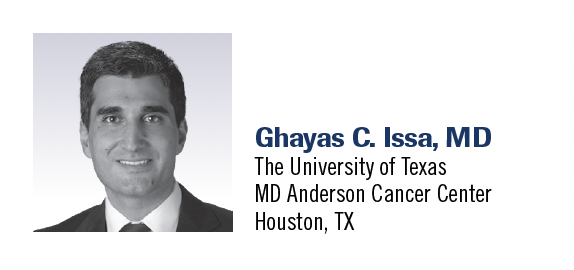Menin Inhibitors Show Promise in Future AML Treatment
Ghayas C. Issa, MD, gave an all-encompassing review of current treatment options for acute myeloid leukemia and what to expect in the future.
Ghayas C. Issa, MD
The University of Texas MD Anderson Cancer Center
Houston, TX

Ghayas C. Issa, MD, discussed the current treatment landscape of acute myeloid leukemia (AML) during an OncView® hosted in December 2023 by CancerNetwork®. Issa, a medical oncologist from The University of Texas MD Anderson Cancer Center in Houston, reviewed the different patient profiles he observes in his practice, the diagnosis of AML, and relevant trials relating to the treatment of patients with AML. He also touched on how he hopes to see the field evolve and the evolution of menin inhibitors in the space.
AML Patient Profile and Diagnosis Options
To begin, Issa noted that patients with AML typically present with a high or low white blood cell count. A diagnosis of AML is made through a bone marrow biopsy. Approximately 50% of the patients he sees in the clinic have AML and have progressed on previous lines of therapy.
For a patient to be considered in remission, there must be a disappearance of leukemia under the microscope during a bone marrow biopsy. If the blasts are less than 5%, it is considered a remission.
“We rely on more testing to corroborate these findings. Some of them would be flow cytometry and then mutational testing, so if [patients] have blasts less than 5% on the bone marrow and their normal cells have recovered, this would be called a complete remission. There are other forms of remission, such as complete remission with incomplete recovery,” Issa said.
Although testing for remission occurs, clinicians are also looking for residual disease. Issa noted that patients who have residual disease typically do worse than patients who do not. Relapse is detected through a blood test indicated by a drop in their blood counts or the presence of leukemia cells.
Certain trials rely on specific phenotypes to identify AML; Issa prefers the mutations and cytogenetics route. This is because abnormalities that are present can be easily defined, he said.
Rearrangements in the KMT2A pathway can be caused by
2 chromosomes attaching almost like “2 wires that are crossed,” Issa explained. When an abnormal signal occurs, this can lead to AML. For this gene expression to happen, a cofactor such as menin is needed. A disruption, like a menin inhibitor, occurs when clinicians disrupt this interaction.
“By removing menin, we can shut down the gene transcription that causes leukemia leading to an antileukemic effect,” Issa said.
Efficacy Results and Safety Observed During AML Treatment
Issa discussed the use of revumenib in the phase 1/2
AUGMENT-101 trial (NCT04065399).1 The investigators, with Issa as lead author, found that adding a menin inhibitor to revumenib did not cause any severe adverse effects (AEs).
The most common treatment-emergent AEs (TEAEs) were prolongation of the QT interval (56%), nausea (50%), vomiting (40%), and febrile neutropenia (31%). Grade 3 or higher TEAEs included febrile neutropenia (31%), thrombocytopenia (19%), and sepsis (18%). Frequent treatment-related AEs (TRAEs) included prolongation of the QT interval (53%). The most common grade 3 TRAE was prolongation of the QT interval (13%).
Additional efficacy end points were presented at the 2023 American Society of Hematology Annual Meeting and Exposition in December. “These data are promising and probably will lead to FDA approval [of revumenib]. The FDA submission is planned for the end of the year,” Issa said.
The phase 1/2 KOMET-001 trial (NCT04067336) analyzed ziftomenib monotherapy in patients with an NPM1 mutation and KMT2A-rearranged relapsed/refractory AML.2 There was a 35% complete remission rate and a 45% overall response rate.
All-grade TEAEs occurred in 95% of patients with NPM1 mutations. The most common were diarrhea (45%), hypokalemia (40%), and nausea (30%). Grade 3 or higher TEAEs included anemia (25%) and thrombocytopenia (20%). Any-grade TRAEs in patients with NPM1 mutations were nausea (20%) and differentiation syndrome (20%).
When looking at both of these agents compared with chemotherapy, Issa noted the toxicity profile is minimal. The main AE is QT prolongation, which can be asymptomatic and managed easily. Issa also noted that there has been increased education around myelosuppression; it can be difficult to determine if it’s caused by leukemia or a menin inhibitor.
Looking Toward the Future
When asked what is most promising in this space, Issa responded with menin inhibitors, especially with potential combination options such as venetoclax (Venclexta). Other promising targeted agents include FLT3 inhibitors, IDH inhibitors, and combinations plus investigational agents that target epigenetic regulation.
Because immunotherapy for AML is still being investigated, Issa thinks there are a few options.“I’m also excited about other epigenetic regulators or drugs that target epigenetic regulation,” he said. “One of them would be [FHD-286], which targets BRG1 and BRM complex. That may lead to similar mechanisms of differentiation.”
Issa believes there needs to be more accurate molecular profiling in the relapsed/refractory AML space. Targeted sequencing is important to acquire the mutational information for patients who have relapsed so clinicians know which therapy to offer next.
For example, NPM1, a common mutation patients have at diagnosis, will often still be around during relapse, he said. However, during treatment, an FLT3 mutation could be acquired and alter the next round of sequencing. He hopes that routine testing for these abnormalities will become more common.
REFERENCES
- Issa GC, Aldoss I, DiPersio J, et al. The menin inhibitor revumenib in KMT2A-rearranged or NPM1-mutant leukaemia. Nature. 2023;615(7954):920-924. doi:10.1038/s41586-023-05812-3
- Erba HP, Wang ES, Issa GC, et al. Activity, tolerability and resistance profile of the menin inhibitor ziftomenib in adults with relapsed or refractory NPM1-mutated AML. Presented at: Society of Hematologic Oncology Annual Meeting 2023; September 6-9, 2023; Houston, TX. AML-475.